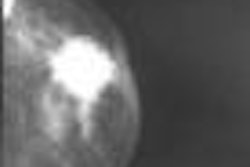Is a new study in the Journal of the National Cancer Institute (JNCI), which questions the benefit of breast cancer screening for reducing mortality, yet another example of how general medical journals are out to undermine the modality? Yes, according to a U.S. breast imaging specialist.
In an American Journal of Roentgenology commentary, Dr. Daniel Kopans states that several major journals, such as the JNCI, have "an undeclared biased publication policy (and) knowingly refused to provide women with accurate information (about mammography screening)" (AJR, July 2005, Vol.185:1, pp. 176-182).
"I am angry and disappointed, but I am not surprised," Kopans told AuntMinnie.com in reference to the latest JNCI article, which suggests that the reduction in breast cancer deaths associated with screening is not significant from a statistical standpoint.
Kopans is the director of breast imaging at Massachusetts General Hospital and a professor of radiology at Harvard Medical School, both in Boston.
Besides JNCI, Kopans takes the New England Journal of Medicine and the Journal of the American Medical Association to task for publishing more negative articles about mammography than positive ones. In particular, he claims these journals perpetuate a "misrepresentation" that breast screening is not necessary before the age of 50.
Kopans went on to say that two published articles, which he co-authored, in favor of screening at ages 40-49 were severely limited in length by the editors of the aformentioned journals.
Along with the AJR commentary is a piece that Kopans produced explaining why the age 50 is an arbitrary cutoff point for screening, and that there are benefits to starting screening at age 40. All three of the journals mentioned above turned down the article, according to Kopans.
Dr. Joann Elmore, co-author of the current JNCI paper, told AuntMinnie.com that her group chose to publish in a general medicine journal, rather than a specialty journal, because the study addresses both mammography and clinical breast exam. "Primary care clinicians and general internists will be interested in this information," she wrote in an e-mail.
As for a publication bias on the part of these journals, Elmore acknowledged Kopans' premise. But she said that this bias may work more in mammography's favor.
"This is usually a bias against publishing 'negative studies' (which our study was) and studies that do not use a randomized clinical trial design (which our study did not)," she stated.
However, Kopans said he believes this bias goes beyond the journals, especially among the primary care physicians (PCP) that Elmore said she hopes to reach.
"The average PCP has only a few women each year who have breast cancer," he said. "Most physicians believe what they read in the journals on the topic and don't care to understand the details."
By Shalmali Pal
AuntMinnie.com staff writer
July 20, 2005
Related Reading
Benefit of breast cancer screening small - study, July 20, 2005
Part II: Breast rads believe malpractice fears prompt more recalls, June 28, 2005
Breast rads believe malpractice fears prompt more recalls, June 28, 2005
Copyright © 2005 AuntMinnie.com



















